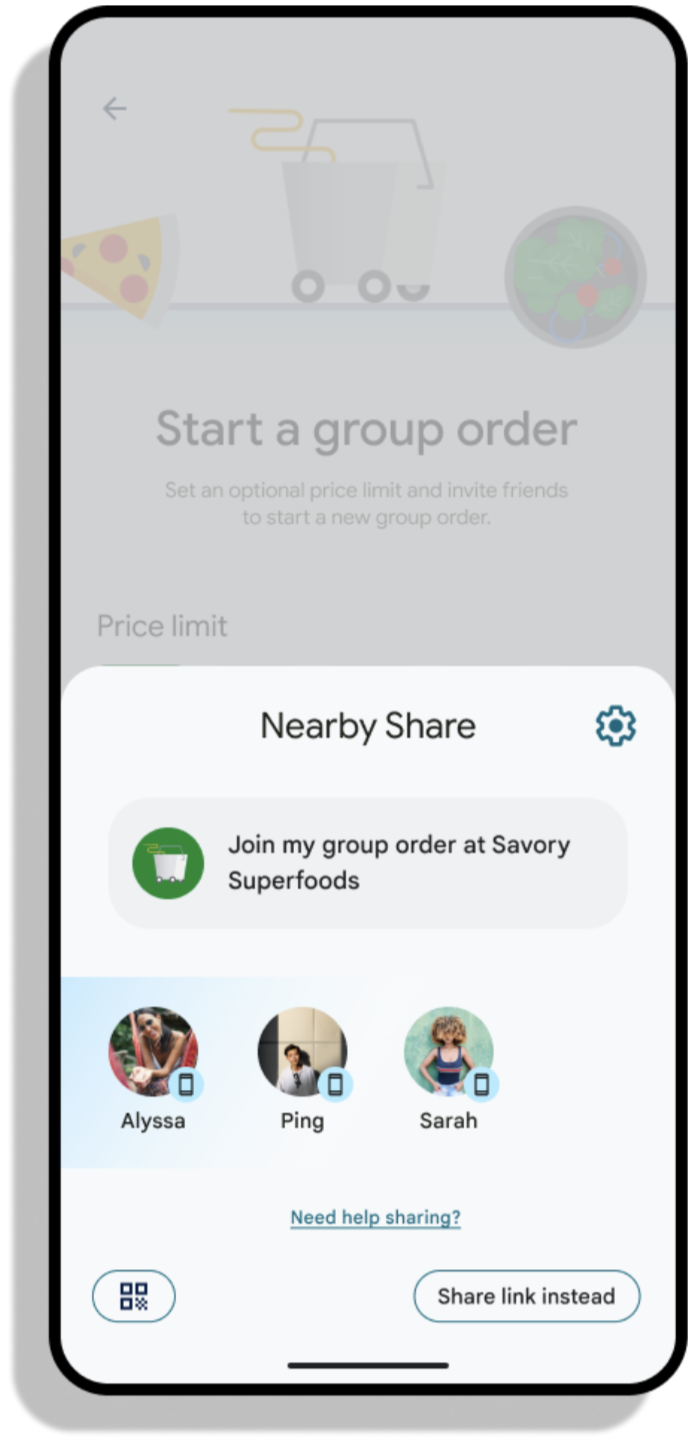几乎所有的多设备体验都始于寻找可用的设备。接收者 可简化这项常见任务,因此我们提供了 Device Discovery API。
 <ph type="x-smartling-placeholder">
<ph type="x-smartling-placeholder">启动设备选择对话框
设备发现使用系统对话框来让用户选择目标设备。接收者
启动设备选择对话框,您首先需要获取设备发现
客户端并注册结果接收器。请注意,类似于
registerForActivityResult,则此接收器必须无条件注册为
部分。
Kotlin
override fun onCreate(savedInstanceState: Bundle?) { super.onCreate(savedInstanceState) devicePickerLauncher = Discovery.create(this).registerForResult(this, handleDevices) }
Java
@Override public void onCreate(@Nullable Bundle savedInstanceState) { super.onCreate(savedInstanceState); devicePickerLauncher = Discovery.create(this).registerForResult(this, handleDevices); }
在上面的代码段中,我们有一个未定义的 handleDevices 对象。更新后
用户选择要连接的设备,在 SDK 成功连接后
连接到其他设备时,此回调会收到 Participants 列表
已选择。
Kotlin
handleDevices = OnDevicePickerResultListener { participants -> participants.forEach { // Use participant info } }
Java
handleDevices = participants -> { for (Participant participant : participants) { // Use participant info } }
注册设备选择器后,使用 devicePickerLauncher 启动它
实例。DevicePickerLauncher.launchDevicePicker 接受两个参数:
设备过滤器列表(请参阅下文)和 startComponentRequest。通过
startComponentRequest 用于指示应在哪个 activity 上启动
接收方设备,以及向用户显示的请求原因。
Kotlin
devicePickerLauncher.launchDevicePicker( listOf(), startComponentRequest { action = "com.example.crossdevice.MAIN" reason = "I want to say hello to you" }, )
Java
devicePickerLauncher.launchDevicePickerFuture( Collections.emptyList(), new StartComponentRequest.Builder() .setAction("com.example.crossdevice.MAIN") .setReason("I want to say hello to you") .build());
接受连接请求
当用户在设备选择器中选择设备时,
请求用户接受连接。一旦接受,
启动了目标 activity,这可在 onCreate 中进行处理,
onNewIntent。
Kotlin
override fun onCreate(savedInstanceState: Bundle?) { super.onCreate(savedInstanceState) handleIntent(getIntent()) } override fun onNewIntent(intent: Intent) { super.onNewIntent(intent) handleIntent(intent) } private fun handleIntent(intent: Intent) { val participant = Discovery.create(this).getParticipantFromIntent(intent) // Accept connection from participant (see below) }
Java
@Override public void onCreate(@Nullable Bundle savedInstanceState) { super.onCreate(savedInstanceState); handleIntent(getIntent()); } @Override public void onNewIntent(Intent intent) { super.onNewIntent(intent); handleIntent(intent); } private void handleIntent(Intent intent) { Participant participant = Discovery.create(this).getParticipantFromIntent(intent); // Accept connection from participant (see below) }
设备过滤条件
在发现设备时,您通常希望过滤这些设备, 显示与当前用例相关的选项。例如:
- 过滤出带有摄像头的设备,以帮助扫描二维码
- 进行过滤,仅显示电视,以提供大屏幕观看体验
对于此开发者预览版,我们首先提供过滤功能 同一用户拥有的设备。
您可以使用 DeviceFilter 类指定设备过滤条件:
Kotlin
val deviceFilters = listOf(DeviceFilter.trustRelationshipFilter(MY_DEVICES_ONLY))
Java
List<DeviceFilter> deviceFilters = Arrays.asList(DeviceFilter.trustRelationshipFilter(MY_DEVICES_ONLY));
定义设备过滤器后,您便可以启动设备发现。
Kotlin
devicePickerLauncher.launchDevicePicker(deviceFilters, startComponentRequest)
Java
Futures.addCallback( devicePickerLauncher.launchDevicePickerFuture(deviceFilters, startComponentRequest), new FutureCallback<Void>() { @Override public void onSuccess(Void result) { // do nothing, result will be returned to handleDevices callback } @Override public void onFailure(Throwable t) { // handle error } }, mainExecutor);
请注意,launchDevicePicker 是一个异步函数,使用
suspend 个关键字。
